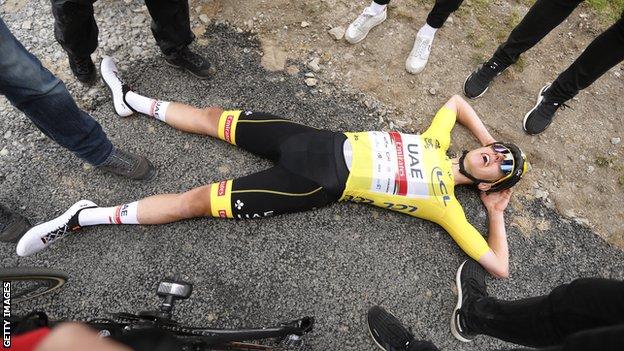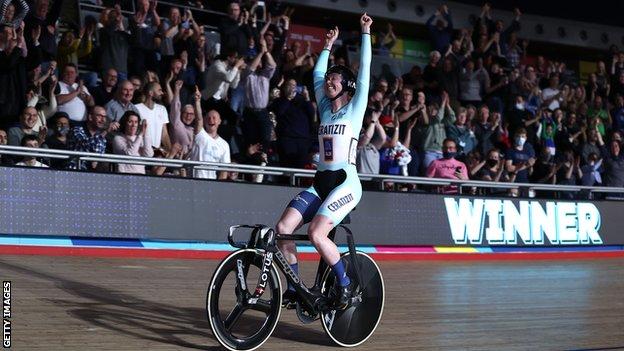Last updated on .From the section Cycling
Cycling has attracted its fair share of attention in recent weeks – just as it enters a new phase trying to build on its popularity.
The sport’s most influential figure, David Lappartient – president of world governing body the UCI, probably didn’t have transgender cyclist Emily Bridges in mind to help propel cycling into the conscience of a wider audience.
But that’s what he got, perhaps precipitated by his own reflections in an interview with BBC Sport.
Speaking just hours before the UCI ruled Bridges could not compete in her first women’s race, Lappartient said he was “a little bit worried” that transgender women participating in female events would “affect the fairness of competition”.
“We can’t solve this alone,” he added. “We have to work together. And this is something we have to do within the next months.”
On an oversized sofa in a London hotel lounge, crowded by TV cameras and Swiss delegates, the amiable Frenchman also talked about cycling’s other social responsibilities, and its foray in the world of sports documentaries, including a Tour de France Netflix series and the UCI’s documentary about the Track Cycling Champions League.
Following re-election last year, Lappartient knows there is work to do and that the sport is facing its biggest challenges since its doping omerta was smashed a decade ago.
Bike racing, it seems, will never be short of talking points.
How sustainable is elite cycling?
Many see cycling as part of the answer to sustainable mobility – with transport in all its forms considered to account for about a third of all carbon emissions globally.
At first glance, professional cycling’s carbon footprint could be perceived to be the lowest of all sports under pressure to curb their emissions. But no other sport shares its challenges.
Despite establishing a pledge to be carbon neutral by 2030 – in line with the International Olympic Committee’s strategy for all its sports – and reduce emissions by 50%, the UCI has been slow to reveal what its carbon footprint is when taking into account all top-level cycling events under its jurisdiction.
While the UCI is yet to publish results of a 2019 study, Formula 1 released details of its own 256,000-tonne footprint at the end of that year.
“We will discuss and have a debate about the agenda 2030 at the next UCI management committee in June, and this will be submitted to the UCI congress in September,” Lappartient said. “Then we will be able to publish what is the reading for us.
“It’s a journey we have to make together. Of course, the institution has to be the leader.”
The concern for many in the sport is that while the athletes toil away in the high mountains of Europe and beyond under their own steam, the support for any World Tour race consists of an estimated 45 cars, 30 motorbikes and two helicopters – all tracking the peloton, often for more than 200km each day.

The 33 World Tour road cycling races on the men’s roster in 2022 account for 159 days of racing – producing emissions between four and six hours each day riders are on the move. Add to that the women’s road cycling season of 72 days of racing across 27 events and it could amount to a sizeable carbon outlay.
This does not cover the travel of fans, team logistics, or the requirements of TV signal relays.
Are that many vehicles needed? And can helicopters be replaced by drones?
“That is something we really have to consider,” said Lappartient. “To not hesitate to turn the table and change our habits. This is really something we will publish in all our guidelines.
“We are looking at whether there are different ways to do this. For road cycling, it’s a little bit more challenging. For road cycling, you can’t use drones, because sometimes it is seven hours [of] live TV. But sometimes instead of having so many helicopters for guests, if we can reduce, then we’ll have to. We want to reach a target of reducing by 50%.
“Also because it’s noisy. I remember, at the Olympic Games for the BMX race they were using two helicopters and I was wondering why [they] had two helicopters for the carbon footprint, and also the noise.”
‘Talented’ Pogacar sometimes tested three times a day
Given cycling’s history is tainted by drug scandals, it is perhaps inevitable that suspicious glances can be cast in the direction of dominant performers.
Lappartient says he is happy with what he sees in reigning two-time Tour de France champion Tadej Pogacar, acknowledging his own flippancy when he says he is simply “pushing more on the pedals”.
The 23-year-old Slovenian has won three of the six races he has contested so far this year, narrowly missing out in the others.
He has not ‘cracked’ on the highest mountain climbs and only in one-day races, which rely more on the timing of a sprint and the moment of attack, has he lost out to more physically punchy competitors.

“Tadej Pogacar is part of a limited group of champions who were really very strong and you know he had so many tests; sometimes he has been test[ed] three times a day and all of this was clear, and we have to respect these good results.
“But I think he is also very strong in his mind. You feel that he has no pressure on his shoulders. He is not afraid to lose.
“These talented riders, they can be very good at a very young age.”
While the sport has seen a handful of positive tests and subsequent bans for riders from teams just below World Tour level, it is not clear whether there had been an increase across the previous decade.
The International Testing Agency acknowledges there has been a drop in in-competition tests during the coronavirus pandemic, but says “surveillance” of athlete biological passports, “intelligence and investigations” continued “seamlessly”.
| 2019 | 2020 | 2021 | |
| In-competition tests | 6,704 | 2,935 | 4,347 |
| Out-of-competition tests | 7,629 | 6,589 | 8,477 |
| Overall | 14,333 | 9,524 | 12,824 |
Ride to Survive
As cycling looks to the future it wants to open its doors to a wider audience, starting with a new Tour de France Netflix series from the producers of Formula 1’s widely acclaimed Drive to Survive. It is set to be filmed at this year’s race, for a series release in 2023.
Eight teams will be featured heavily, including two of the biggest – British squad Ineos Grenadiers and Dutch rivals Jumbo-Visma.
Ineos rider Tom Pidcock says it will be “massive for the sport” but not everybody shares his enthusiasm, with Pogacar’s UAE-Team Emirates declining to take part.
The Tour is considered one of the world’s biggest sporting events for TV audience reach, and the top male riders earn in the region of 5-6 million euros a year.
Lappartient is keen for the project to work for Tour organisers ASO but wants earnings to trickle down to other areas of the sport, hence the UCI’s approach to the “innovation” of track cycling.
The Track Cycling Champions League, which ran last year from June to December, now has its own series Back on Track – currently airing on Eurosport.
In a departure from the more conventional Olympic look, velodromes played host to a lightshow, riders in striking skinsuits and plenty of associated glitz.

“I think Back on Track is really import for people to understand what is behind the scenes,” said Lappartient. “They can see the race on TV but now they can understand exactly how the disciplines work, the pressure on the athletes.
“I think it’s really import to give some keys for the fans to understand more and discover more about the athletes because they are not always well known.
“Innovation is key and the Track Champions League is an innovative format. Whether the fans are in the velodrome or behind the TV or the tablet they can feel like they are part of this journey.
“When you discover track cycling, for sure you will come back because you will love it.”


